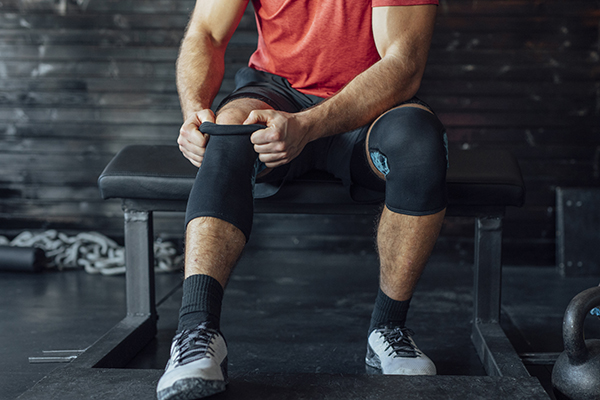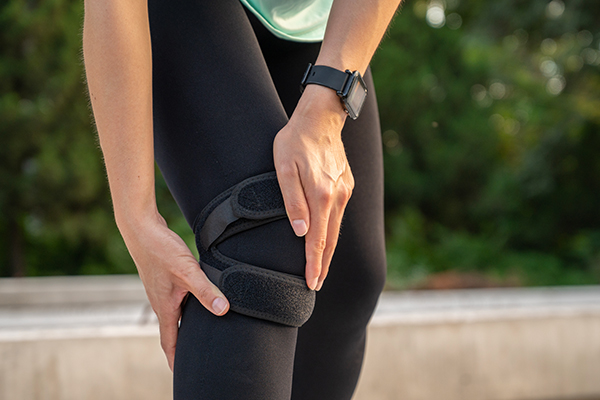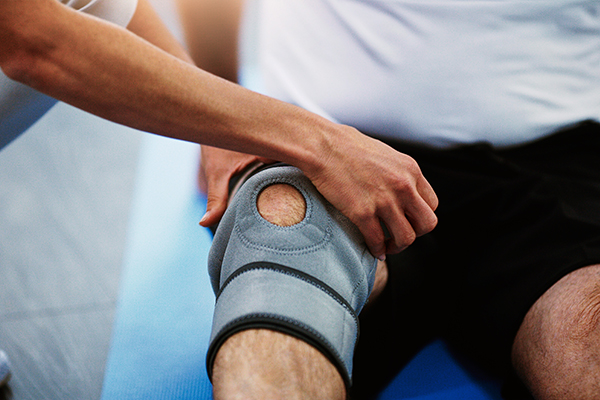Do Knee Bands Really Work?

You’ve seen them on everyone from professional athletes to friends and family members recovering from knee injuries.
But can a knee support brace or knee band actually help to reduce stress on your joint and alleviate pain? Here’s what you need to know.
What Is a Knee Support Brace?
A knee band or knee brace is a supportive device worn on the knee to provide support, stability, or pain relief.
Knee braces come in a variety of materials, sizes, and designs. They may be worn directly on the skin or over clothing.
While some knee support braces are sold over the counter in pharmacies and specialty stores, others must be custom-fitted by a certified orthotist.

Generally speaking, knee braces fall into one of two categories:
Sleeves
Typically made of neoprene or a combination of latex, nylon, and spandex, sleeves are often used by athletes and everyday recreationists.
Sleeves are inexpensive and easy to find, says David Jeter, MPT, COMT, owner of Acceleration Physical Therapy in Spokane, WA.
But they provide little in the way of stability and support.
“The benefit of a knee sleeve is that it keeps the knee warm, can offer some compression, and might feel like it is offering support,” Jeter adds. “As you can imagine, though, your body weight is going through that knee and the neoprene has almost no ability to resist that movement.”
Hinged Braces
Hinged braces are designed to offer more support to the knee than a sleeve, as they often feature adjustable straps, support stays, and hinges.
The level of support a hinged brace offers depends on its rigidity, size, and construction.
“A hinged brace is usually used after a ligament injury or surgery, such as an ACL (anterior cruciate ligament) reconstruction,” Jeter says.
While the soft tissues heal, the brace restricts or limits front-to-back and side-to-side motion.
What Are Knee Bands?

Knee bands, also known as patellar tendon straps, are popular among runners, walkers, and weightlifters.
More minimalist than a standard knee support brace, a knee band consists of a narrow strip of material that wraps around the leg just under the kneecap.
Most include adjustable velcro closures and some designs also include straps that fit above the kneecap.
Knee bands are designed to be worn during physical activity.
The purpose of the strap under the patella is to put direct pressure on the patellar tendon, Jeter says, which may help to reduce strain on this tendon.
But while this may temporarily help with pain, it won’t treat the underlying issues causing that pain.
“I like to look at the leg as a whole and determine what parts are not performing their job such that the patellar tendon has more stress on it,” Jeter says. “The solution is to fix the root of the problem.”
Pros and Cons of Wearing a Knee Support Brace or Band

If you deal with knee pain or are recovering from an injury or surgery, wearing a knee band or knee support brace may be beneficial.
However, it’s important to consult with your doctor to determine which type (if any) is most appropriate for managing your knee pain.
Here are a few potential benefits and pitfalls to wearing a knee band or brace.
PRO: Recovery
Following surgery or an injury, a hinged brace can help immobilize the knee joint so that the damaged tissues can heal.
However, the overall effectiveness of wearing a knee brace after ACL surgery is still up for debate.
CON: False sense of security
While a hinged brace provides support to a healing injury, it’s not a substitute for a healthy, fully functional joint.
Even the sturdiest hinge brace can’t completely limit rotational movement.
“Because the brace is on the outside of the leg, there is a tremendous amount of soft tissue between the brace and the bone,” Jeter says.
That rotational movement, combined with side-to-side motion, could potentially lead to an ACL injury, Jeter adds.
PRO: Support
Wearing a knee support brace — particularly a soft, sleeve-style brace — may help individuals with knee pain, osteoarthritis, or a history of knee injuries feel more supported and confident in their movement.
CON: Treating the symptom
A knee brace or band may help alleviate pain, but it won’t treat the underlying issue that’s causing that pain.
And because it helps to minimize pain, you may put off seeking treatment for a knee injury, which could ultimately make the issue worse.
PRO: Comfort
“A knee brace can make the knee feel better, and that is important,” Jeter says. “It will not make the knee weaker, and it is not detrimental to wear, so if someone feels better in one, wear it.”
However, it’s still important to talk to a medical professional who can help determine the cause of your knee pain.
